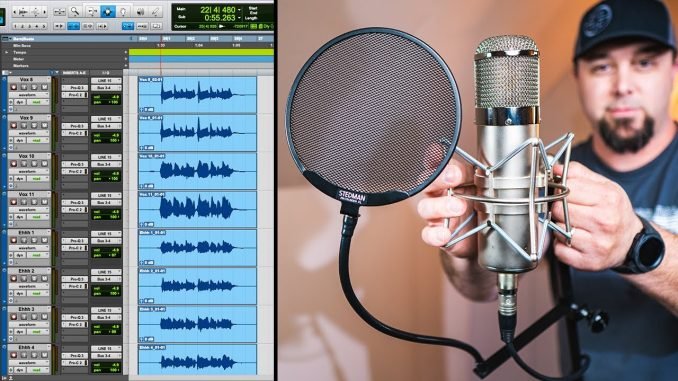
Step right into a world where your vocals are not just solitary, standalone elements in your music tracks. Discover the realm of depth, richness, and musical textures by diving deep into vocal layering techniques—a realm where every singer has the potential to sound like an ensemble. This comprehensive look at vocal layering will educate you, arouse your musical senses, and inspire you to create more intriguing music.
Understanding Vocal Layering
Vocal layering exists as a phenomenon where multiple recorded vocals are carefully structured over each other to generate a rich, full-bodied sound. The intriguing fact about this technique is that it gives you full control, allowing you to adjust the volume of every single layered track. It’s a distinctive method used to provide depth to songs and develop complex vocal tones often hailed in today’s music.
Importance of Vocal Layering
Where monotony becomes a threat to creativity, vocal layering swoops in as the hero. Whether for a solo artist desiring a choir-like background or simply to add some extra dimension to the performance, vocal layering can significantly enhance the overall sound output. But remember, it’s also crucial to maintain a sensible approach when applying these techniques for better audio perception.
The Basics of Vocals
With an entire ocean of vocal diversity at your disposal, it’s vital to understand some fundamental concepts. Beginning with the basic aspect—vocal tracks—are merely individual recordings that collectively contribute towards your final sound masterpiece.
Your vocal elements can be classified into various categories such as main vocals and backing vocals. Main vocals usually take center stage with their powerful melodies while backing vocals play supportive roles that harmonize or offer rhythm assistance without stealing the spotlight from main vocals.
Exploring the Types of Layering Techniques
Once you understand what voices you’re working with embark on your exciting journey with one of four common layering techniques at hand.
The Overdub Technique
Overdubbing is arguably one of the most popular layering techniques known in music production. It involves recording successive vocal parts over previous ones while carefully manipulating aspects like dynamics, pitch, and timing till they match perfectly.
Harmony or Choral Technique
If lush vocals and harmonic richness are what you’re after then adopting a harmony technique is ideal for you. Here’s when varying pitches and intervals sing along simultaneously, wrapped nicely around your lead vocals for fuller sonic detail.
Call-and-Response Technique
This technique owes its origins to gospel and blues traditions but has found favor across various music genres today. As its name suggests, one line sings out (call) followed by different lines as responses creating an engaging conversational pattern in your music.
Double Tracking Technique
Lastly introducing double tracking- where duplicating lead vocals creates that ever-sought depth while adding character to your song.
Harnessing the Power of Panning
Panning is a remarkable tool you have at your disposal to enrich the layers of your vocal tracks. Essentially, panning involves distributing sound across left-right stereo channels to craft captivating audio environments. Thoughtful panning enhances the stereo width and provides an immersive audio experience unlike any other for your listeners. To take full advantage of this technique, consider getting voice coaching.
Understanding Frequency Spectrum in Layering
Even within multitudes of bundled waveforms lies freedom with thoughtful manipulations bringing unique sonic identity characteristic of each voice.
The Concept of Frequency
This involves understanding how sonic details distribute themselves across frequencies within the limited space available.
Using Frequency Spectrum
Knowing how frequencies spread helps decide how elements fit together avoiding clashing sounds consequently maintaining clarity even amidst layered cues.
Identifying and Managing Layering Challenges
However effortless it might appear on surface layers, dealing with certain technical glitches could make this task feel daunting unless properly addressed.
Navigating Phase Issues
Learning about phase cancellation helps eliminate any chances where sounds might undermine each other causing the phrase ‘thinning’ instead of enrichment.
Avoiding Over-Processing
While striving for quality sounds refrain from unnecessary processing lest it leads to negative impacts on overall mix causing loss in vital details.
Pro Tips for Superior Layering
With foundational knowledge in place here’s how you refine your skill set with extra helpings of pro wisdom.
Experiment with Reverb
Reverb helps increase space perception lending more roominess hence depth around layered vocals making them pop right out!
Learning EQ Techniques
Harness efficient equalization learning how frequency shaping further enhances vocal texture resulting in richer audio experiences.
Master Compression Application
Compression aids controlling dynamic range where needed yielding consistency across all layered sound elements thus maintaining balanced outputs always.
Evolving Technologies in Vocal Layering
Auto-Tune and Digital-Music-Workstations (DAW) both pioneered technological advances taking loads off physical hardware compared earlier times simplifying otherwise tedious tasks like real-time pitch correction or quick mockups respectively giving creative freedom without bounds!
Creating Your Own Layering Style
Finally taking plunge toward personalized styles will finally mark footprints forever etched within music industry sands.
Balancing Creativity and Technique
It’s important balancing these two edges even though it might seem challenging initially, rest assured that attaining this equilibrium only serves best outcomes always!
Personalizing Vocal Textures
Eventually leaving unique signatures upon ‘texture-canvas’ is what makes musicians stand out among legions others present out there feels through experimenting using variations becoming invincibly creative!
In Conclusion
Exploring vocal layering techniques brings new depth to your music, offering enrichment far beyond the ordinary. Despite challenges, mastering these techniques and creating personalized styles reaps rewards and engages listeners. Embrace the unknown for growth and continue in your journey towards compiling harmony-filled masterpieces. So keep singing, keep exploring!




